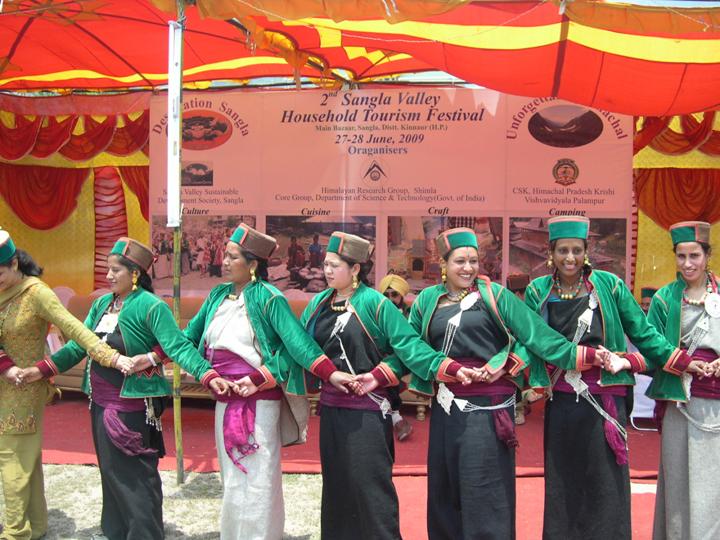
With many foreign tourists from France and Israel present on the occasion the festival is gaining in popularity.
Vidya Karan Negi chairman, Sangla Valley Sustainable Society (SVSDS) who is also festival organizer said the first festival in May 2008 was able to popularize destination Sangla, both for domestic and foreign tourist.
Traditional dishes like Gima (stuffed intestine of goat/sheep) chulphanting (pulp of dry apricot), Brasohaot (Piza kinde base of buckwheat), Hotup (Drink of dry apricot kernels), kinnauri rajmas, and mutter mushroom (Grown especially at Sangla) were the served to the festival visitors.
Dr Lal Singh of the Himalayan Research Group, Shimla, one of the main organizers explained importance of celebrating the festival.
“It is one major opportunity for livelihood development of people in Sangla Valley through capacity building, proper market orientation of the households in preservation and popularization of culture, cuisine, craft and new field of camping,†he said.
Singh emphasized the regular interaction of the people and experts in the field of home stay, food processing, innovative agriculture practices like medicinal plants and mushroom cultivation.
A contingent of the scientists of different research streams from the H.P. Krishi Vishvavidalaya, Palampur, led by Prof. P.K. Sharma, Dean Post Graduate Studies explained the opportunities arising out of climate change coming to this valley by growing of apple in Chitkul and cultivation of highland pastures through early melting of snow fall.
Tested series of colonal root stocks of apple was available form the H.P, Krishi Vishvavidlaya, Palampur said Dr. N. D. Negi, university scientists posted at Kalpa.
Women empowerment by technology transfer under a climate change scenario through cultivation of crop with organic means, indoor cultivation of button mushroom, low cost poly house protected cultivation, medicinal plants cultivation on pastures, development of fodder and fodder processing technologies and passive housing retrofitting for space heating to reduce fuel wood dependence made by Dr. Maninder Jeet Kaur of HRG Shimla was well received by the participants.
Festivities were marked with cultural troupes and others joining in the traditional dance. The food festival, sale of dry fruits, handicraft and handloom items from the stall installed by the local artisan and traders had a busy day.
The festival was organized with support from the Palampur Agriculture University (CSK, Krishi Vishvavidlaya), said Lal Singh.
As Editor, Ravinder Makhaik leads the team of media professionals at Hill Post.
In a career spanning over two decades through all formats of journalism in Electronic, Print and Online Media, he brings with him enough experience to steer this platform. He lives in Shimla.




Sangla valley falls prey to commercial tourism
Rakesh Lohumi
Tribune News Service
Shimla, May 25
The picturesque landscape and serene environs of Sangla valley in Kinnaur district, which made it a favourite destination for foreign tourists, has become the latest victim of unregulated commercial tourism.
The valley is being marred by concrete structures, presenting a stark contrast to the traditional hill architecture. The multistorey buildings are coming up all over the place. Even the village close to the Chinese border, Chitkul, has not been spared. The tourism boom is indeed taking a heavy toll, devouring the valley of its scenic charm and tranquillity.
The government has been harping on promoting eco-tourism, but it is not taking any effective steps to save the tourist destination from falling prey to unbridled forces of commercialisation.
There has been a spurt in construction activities and the traditional timber and stone houses are fast giving way to concrete structures, which do not blend well with the local tribal architecture. The indifferent attitude of the government, which seems to be in no urgency to regulate construction activity, is only hastening the aesthetic degradation of the landscape.
However, in absence of any plan for development of the tourist destination, new structures are coming up in a haphazard way. The main beneficiaries of the tourism boom are tour operators, who take properties on lease and make fast buck during the season.
However, locals stated that ban on green felling and non-availability of timber was the reasons for giving preference to concrete structures over the traditional architecture.
Though these concrete structures are environmentally not satiable for such cold areas, where mercury dips several degrees below the freezing point for a good part of the year and space heating is a big issue. Moreover, timber-framed structures are easy to built and take much less time, locals added.